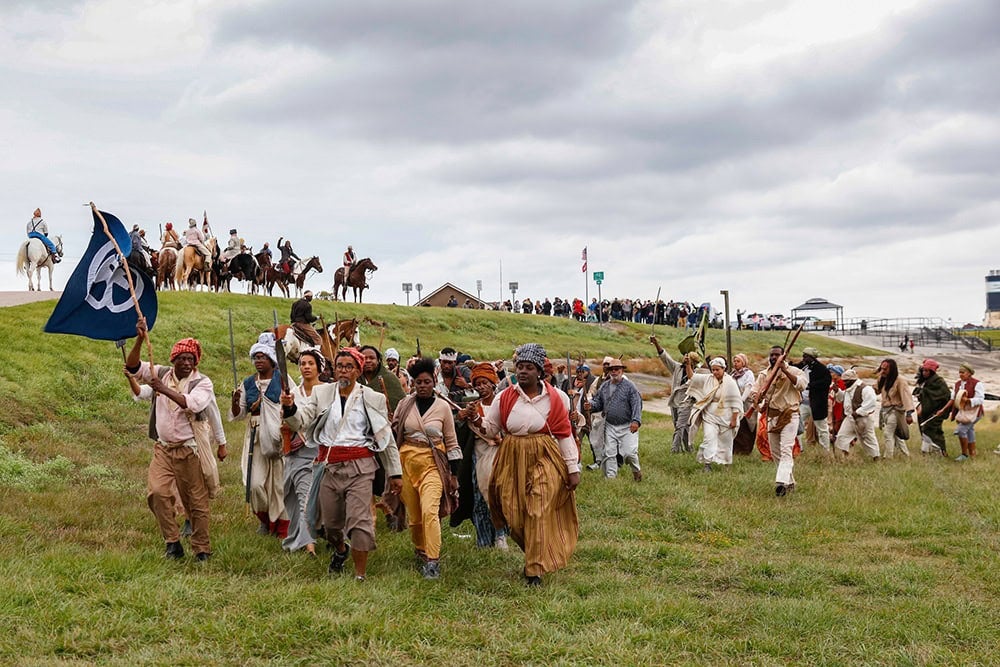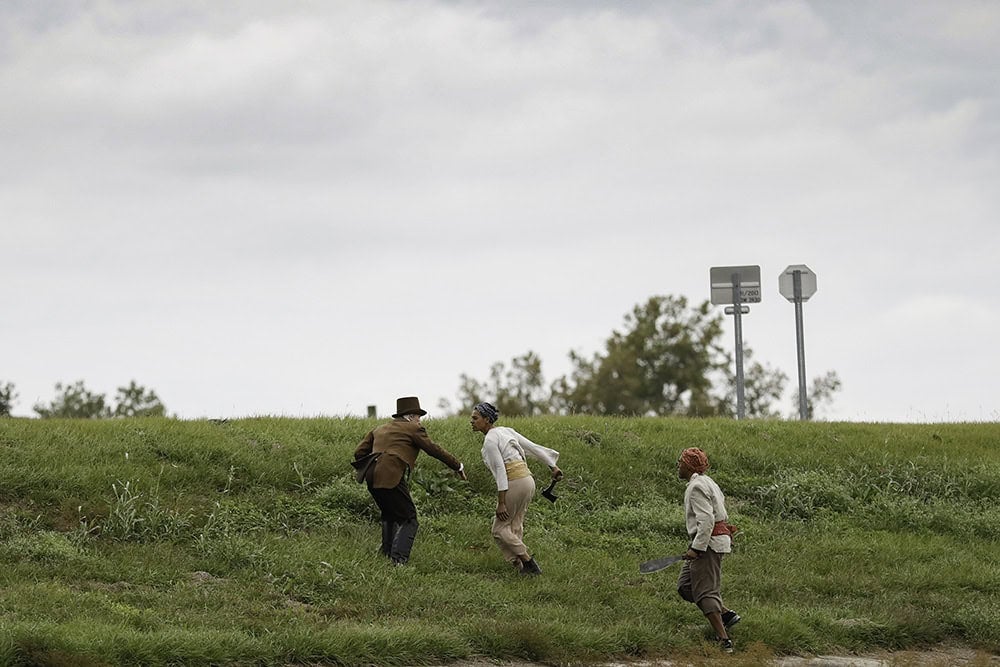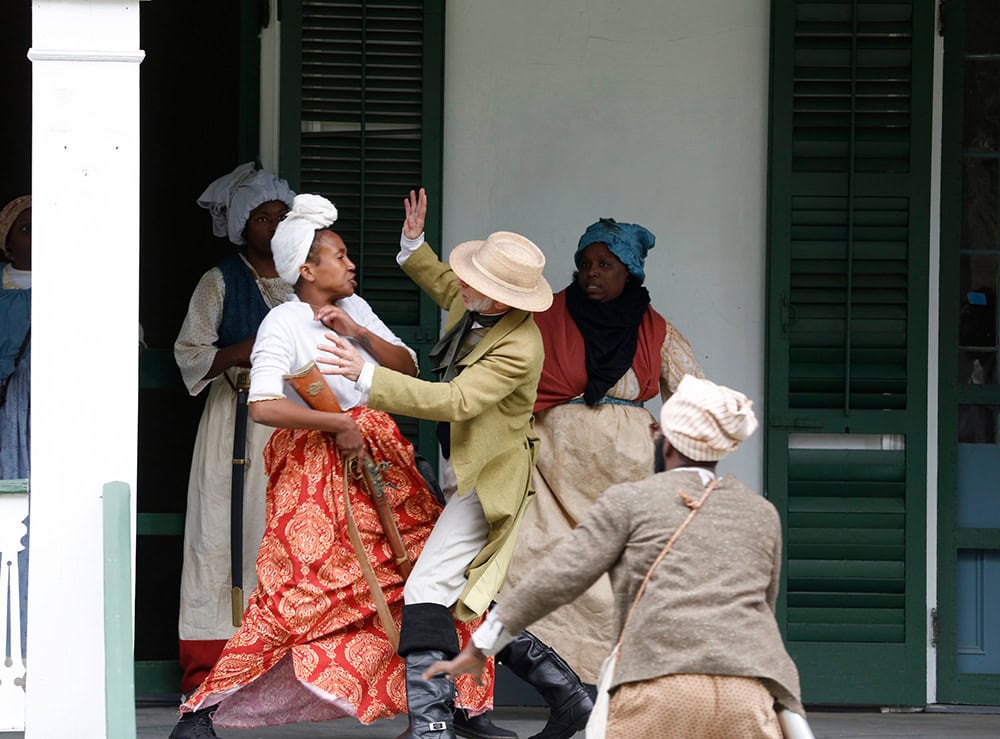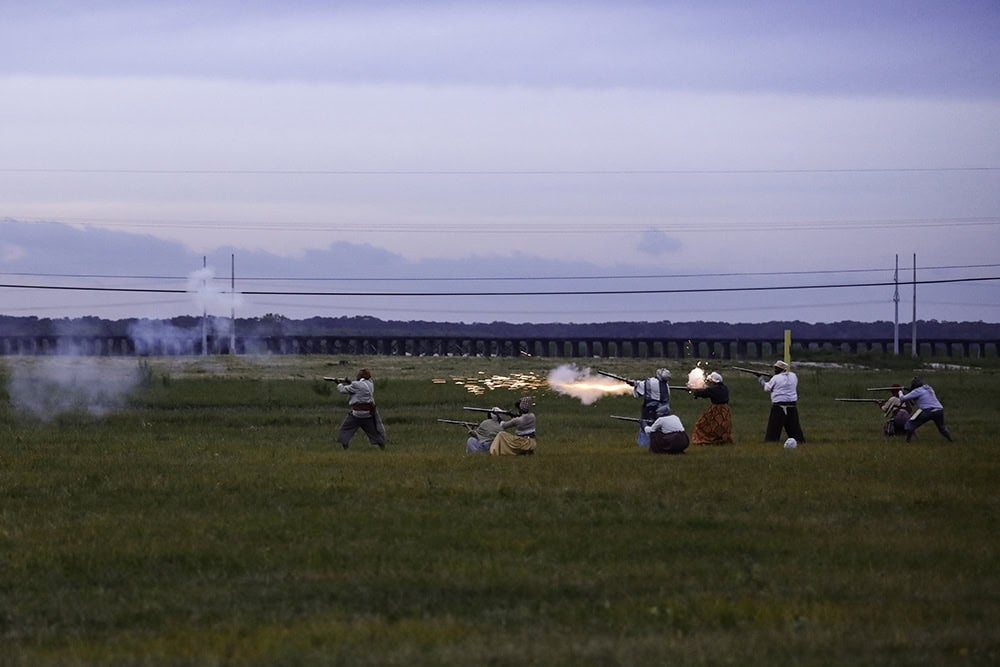This essay is part of German Coast Uprising, 1811 / 2019, a series of stories responding to the Slave Rebellion Reenactment initiated by artist Dread Scott outside New Orleans last November. Read the letter from the editor introducing the series here.

“Qumana avowed that he had figured in a remarkable manner in the insurrection.
ADVERTISEMENTIl n’a denoncé personne (He named no one).”
Edward E. Baptist, The Half Has Never Been Told
The German Coast Uprising, the largest rebellion of enslaved people in United States history, began on January 8, 1811, at the sugar plantation of Manuel Andry, along the banks of the Mississippi River just outside of New Orleans. According to historical accounts, the revolt was instigated and led by Charles Deslondes, an enslaved man who was joined by a legion of armed, rebellious enslaved workers from various plantations. Taking advantage of the post-holiday lull in their work to organize, the rebellion marched downriver toward New Orleans, gathering 500 enslaved participants along the way—some Louisiana-born and many from the Caribbean and West Africa—including ones from the Belle Point Plantation in Reserve, Louisiana. Among those joining the insurgency was a young Ashanti man (most likely from present-day Ghana) named Quamana, whose own words remain in court documents as a witness.
It is impossible for me to isolate when exactly it was that I first learned of the 1811 German Coast Uprising. My grandmother was born in Reserve, and many members of my extended maternal family still live there. Today, the residents of Reserve face a cancer rate that is fifty times the national average, with a synthetic rubber plant—built on the former site of Belle Point Plantation—emitting carcinogens into the community’s air supply.
I recall more precisely when I learned other piercing history lessons. My fifth-grade social studies class was where I learned that Eli Whitney invented the cotton gin. I remember reading about how this invention, the technology that made cotton “king,” contributed to productivity, and about the mercy it allegedly extended to the oft-pricked fingers of those forced to pick the crop. The absurd cruelty of this kind of education. Never mind that it was sugar, not cotton, that many of our families were forced to cultivate in southern Louisiana. Never mind sugar cane’s skin-cutting leaves.
The German Coast revolt was ultimately put down about twenty miles north of New Orleans on January 11, 1811, by a combination of federal troops and militia. It is estimated that between the battles, executions, and torture that followed, up to one hundred Black people were killed. The story of the 1811 revolt was told to us by our parents, elders, professors, and the Black teachers at my tiny Catholic school in New Orleans East; they filled in what our history textbooks left out.

A couple of years before I learned the name Eli Whitney, I learned the name Latasha Harlins. She was the fifteen-year-old girl in Los Angeles who was shot in the head by a grocery-store owner who accused her of shoplifting, just two weeks after the videotaped beating of Rodney King. Her killer received probation and no jail time. Her name reemerged in my psyche decades later, following the 2013 death of Miriam Iris Carey. Carey, an unarmed thirty-four-year-old Black woman, was shot to death in her car in Washington, D.C., by Secret Service agents—with her 18-month-old daughter in the backseat at the time. The shooting was precipitated by Carey allegedly trying to cross a Secret Service checkpoint, a report later deemed to be false—an alleged “mistake.” The lack of outrage and seemingly passive acceptance of Carey’s death led to me write a series of poems in which a character called Maryam de Capita narrates alternative histories of Black female archetypes. Through Maryam’s point of view, I tried to envision these women as living, breathing beings. I wanted to explore the notion of freedom and the transgressive status socially assigned to Black women. I wanted to disrupt the history of the forces that had, many times, vanquished their bodies. Was there power in embracing transgression? Rebellion? Through my contemplation of Maryam’s voice, her own history began to emerge.
I wrote many of these early poems while in an MFA program in the five-year post-Katrina vacuum. While still empty of many of its former Black residents, New Orleans was changing rapidly and the reconstruction left many people culturally and politically adrift. I thought about my family’s history from up River Road to New Orleans, marveling at and mourning the loss of the Black world in which I had grown up. Maryam began to leap off the page and into performances as she revealed to me the story of her origin within “Republica,” the second free Black republic in the Western Hemisphere and the product of the German Coast Uprising. Republica celebrated its independence as a free state on January 12, 1811, with its territory stretching along the Gulf Coast from Galveston to Miami. As an ongoing performance and installation project, Republica: Temple of Color and Sound imagines a victorious 1811 revolt and what the cultural, political, and technological output of an autonomous Black people within North America would have looked like in the time since then. It is, in many ways, dedicated to the New Orleans of my youth.
I thought about my family’s history from up River Road to New Orleans, marveling at and mourning the loss of the Black world in which I had grown up.
Within this world, I began to construct the Temple of Color and Sound as a home for Maryam. It functions as an itinerant sacred and secular space where all timelines meet. In the timeline that features a victorious 1811 revolt, the Temple functions as an intellectual, spiritual, and artistic performance venue where both the like-minded citizens of Republica and select émigrés and visitors gather around its multiple large-scale shrines and assemblages of Maryam’s personal ephemera. In the current political timeline of New Orleans—and the other cities the Temple has traveled to—it functions as a place of dissent and of refuge for those wishing to disrupt oppressive structures and normative conditions in favor of the unexplored, the transgressive. Moreover, it is a place to go amid a politics and practice of displacement that has marked New Orleans and many other rapidly gentrifying cities around the world. In all timelines, Republica: Temple of Color and Sound is dedicated to the principles of the revolt of 1811, to earlier revolts—such as the 1731 Natchez-Bambara conspiracy and the 1795 plot at Pointe Coupee—and to all those who gave their lives to free our bodies and our souls.

This past November, another artist-driven project sought to invoke the 1811 rebellion by way of historical reenactment. Over the course of two days, Dread Scott’s Slave Rebellion Reenactment completed a trek from Manuel Andry’s plantation in LaPlace, Louisiana, to Congo Square in New Orleans. The twenty-six mile, million-dollar-plus production was the culmination of a multi-year collaboration between Scott and the New Orleans arts nonprofit Antenna*, with the support of various foundations and private individuals. Various industrial plants lined the path of the reenactment, providing many photo-ops with thought-provoking juxtapositions. Live coverage of the journey was provided by The Guardian via Twitter. One of the two reporters assigned to tweeting about the event was the paper’s Southern bureau chief, while the other is normally assigned to cover gun violence and mass shootings. It struck me as an odd choice, but it was also macabrely fitting as, following their defeat by federal troops, many of the rebellion’s leaders and participants were publicly executed, their heads impaled on spikes along the road to New Orleans for all to see.
Slave Rebellion Reenactment looked to recast this historic episode as a “community-engaged performance and film production,” with the march doubling as a film set for British filmmaker John Akomfrah. Dressed in approximated period costumes, the reenactors made their way along the modified route shadowed by second and third lines of a film crew and members of the media, respectively. Questions of how to grapple with the rebellion’s bloody end were avoided altogether, as it was replaced by a “cultural celebration” in Congo Square. In a culture that has long made a spectacle of Black suffering, to avoid further brutalizing Black people in the fiction of performance art is the right decision. But to leave their deaths unacknowledged leaves those of us who have lived in their wake feeling a bit hollow. The one depiction of white death featured in Slave Rebellion Reenactment was buttressed by a Guardian reporter’s live tweets of that white actor’s thoughts, feelings, and intention to write about his fictitious death. His story came complete with family lore that he said included the names of militiamen who participated in putting down the rebels. In the microfiction that comprised this series of tweets, a white man dies for, and redeems the sins of, his fathers and is then offered swift compensation. So while the performance avoided unnecessary depictions of the brutal deaths of Black people, another kind of violence was invented. I wondered, as I followed the coverage of the reenactment, for whose benefit and comfort had the violence visited upon us actually been omitted?
While the past was being reenacted, Black people in the here and now are being left in real peril by the brigands.
One reenactor, New Orleans native Kim Coleman, remarked upon the sheer degree to which white spectators outnumbered Black ones. From her perspective, it was a visceral reminder that the project had failed to connect with the very community whose history was being staged. Coleman said that, for her, the contagious excitement and energy that the march started with dissipated quickly. It became clear that the film crew’s need to capture particular shots cinematically was the project’s chief priority. Though she had joined the project through a partnership with a local cultural institution—a form of recruitment that suggests self-selection and proverbial “community engagement”—by day’s end she felt like an anonymous extra. “In the end that’s what we all were,” Coleman said. She did not return for the second day of filming.
William Andersen, who reviewed the reenactment for Hyperallergic, highlighted some of the project’s more uncomfortable ironies, such as the sight of uniformed police—whose modern-day existence in the South can be traced directly to slave patrols of the past—escorting the reenactors along the way. Just this past December, a burial ground in St. James Parish that is thought to contain remains of slaves was slated for development by Taiwan-based Formosa Plastics Company. Local residents were alarmed by news that the parish, already known as “Cancer Alley,” will see the amount of chemicals in its air doubled—the plastics company simultaneously showing callous disregard for both the living and the dead. As I watched imagery from Slave Rebellion Reenactment circulate on the internet, it struck me that while the past was being reenacted, Black people in the here and now are being left in real peril by the brigands.

Slavery is a for-profit industry, so the reality of the capital necessary to stage this reenactment has been one of the more stunning aspects of the project. What is the responsibility of a performance the size of Slave Rebellion Reenactment to the community whose history is its stage? Anderson’s Hyperallergic review raised questions about the project’s metric for compensation and the ethics and implications of paying minimum wage to the Black reenactors contributing the performance’s most crucial labor. How do we measure the “success” or “failure” of such public engagement projects? The images of slave reenactors marching by industrial plants, which negatively affect the lives of Louisiana’s citizens every day, are hard to forget. An art project certainly can’t be expected to be the remedy for, or to carry the responsibility of solving, the problems that it seeks to highlight, but it does have the responsibility to operate ethically in consideration of them. In the week following the project, I spoke with a reenactor after a panel discussion that I participated in alongside Dread Scott. The reenactor and I came to an impasse around the issue of personal catharsis. I don’t doubt that, for some reenactors, the shared experience was secondary to direct compensation. But given the subject matter—particularly when juxtaposed with the grim realities faced by Black residents of the region today—that catharsis must be extended beyond those participating in the project. I continue to question the notion that the detrimental effects of extractive art practices can be mitigated by camaraderie.
It is neither accidental nor incidental that nearly all of our public gatherings in New Orleans deal directly with mortality. Because our dead are buried above ground, life and death exist somewhat simultaneously here. To descend from enslaved people is to always know that previous generations of your family lived with death by another’s hand only an instant away. Bless those who passed on to us the knowledge that we had, as a people, indeed fought back. How do we do justice or, at a minimum, pay respect to the lives and deaths of the enslaved? How do we spare them further harm in the work we choose to create? I did not see the battle scenes that were a part of Slave Rebellion Reenactment. Some reports say they depicted a retreating militia force and the insurgent slaves headed toward victory. But a victory for whom?
Dread Scott’s Slave Rebellion Reenactment took place November 8 – 9, 2019, with reenactors marching between LaPlace and New Orleans, Louisiana.
* Disclosure: The author has worked with Antenna as part of Room 220, the organization’s literary division.




